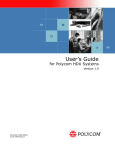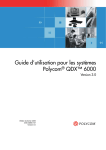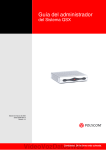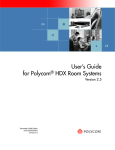Download User's Guide for Polycom HDX Systems, Version 1.0.1
Transcript
product pic here User’s Guide for Polycom HDX Systems Version 1.0.1 December 2006 Edition 3725-23978-002/A Version 1.0.1 Trademark Information Polycom®, the Polycom logo design, and ViewStation® are registered trademarks of Polycom, Inc., and MGC™, People+Content™, People On Content™, VS4000™, and VSX™ are trademarks of Polycom, Inc. in the United States and various other countries. All other trademarks are the property of their respective owners. Patent Information The accompanying product is protected by one or more U.S. and foreign patents and/or pending patent applications held by Polycom, Inc. © 2006 Polycom, Inc. All rights reserved. Polycom Inc. 4750 Willow Road Pleasanton, CA 94588-2708 USA No part of this document may be reproduced or transmitted in any form or by any means, electronic or mechanical, for any purpose, without the express written permission of Polycom, Inc. Under the law, reproducing includes translating into another language or format. As between the parties, Polycom, Inc. retains title to, and ownership of, all proprietary rights with respect to the software contained within its products. The software is protected by United States copyright laws and international treaty provision. Therefore, you must treat the software like any other copyrighted material (e.g. a book or sound recording). Every effort has been made to ensure that the information in this manual is accurate. Polycom, Inc. is not responsible for printing or clerical errors. Information in this document is subject to change without notice. Contents Using the Remote Control . . . . . . . . . . . . . . . . . . . . . . . . . . . . . . . . . . . . . . . . . . . . . . . . . . . . . . . . . 1 Calling and Answering . . . . . . . . . . . . . . . . . . . . . . . . . . . . . . . . . . . . . . . . . . . . . . . . . . . . . . . . . . . 2 Answering a Video Call . . . . . . . . . . . . . . . . . . . . . . . . . . . . . . . . . . . . . . . . . . . . . . . . . . . . . . . 2 Placing a Video Call . . . . . . . . . . . . . . . . . . . . . . . . . . . . . . . . . . . . . . . . . . . . . . . . . . . . . . . . . . 2 Calling by Entering a Name or Number . . . . . . . . . . . . . . . . . . . . . . . . . . . . . . . . . . . . . 2 Calling from the Recent Calls List . . . . . . . . . . . . . . . . . . . . . . . . . . . . . . . . . . . . . . . . . . 3 Calling from the Contacts or Speed Dial List . . . . . . . . . . . . . . . . . . . . . . . . . . . . . . . . . 4 Calling from the Directory . . . . . . . . . . . . . . . . . . . . . . . . . . . . . . . . . . . . . . . . . . . . . . . . 4 Ending a Video Call . . . . . . . . . . . . . . . . . . . . . . . . . . . . . . . . . . . . . . . . . . . . . . . . . . . . . . . . . . 4 Types of Calls You Can Make . . . . . . . . . . . . . . . . . . . . . . . . . . . . . . . . . . . . . . . . . . . . . . . . . . 5 Placing Audio-only Calls and Adding Audio-only Sites . . . . . . . . . . . . . . . . . . . . . . . . . . . 6 Placing an Audio-only Call . . . . . . . . . . . . . . . . . . . . . . . . . . . . . . . . . . . . . . . . . . . . . . . . 6 Adding an Audio-only Call to a Video Call . . . . . . . . . . . . . . . . . . . . . . . . . . . . . . . . . . 6 Adding a Video Call to an Audio-only Call . . . . . . . . . . . . . . . . . . . . . . . . . . . . . . . . . . 6 Ending an Audio-only Call . . . . . . . . . . . . . . . . . . . . . . . . . . . . . . . . . . . . . . . . . . . . . . . . . . . . 7 Controlling What You See . . . . . . . . . . . . . . . . . . . . . . . . . . . . . . . . . . . . . . . . . . . . . . . . . . . . . . . . . 7 Selecting and Adjusting a Camera or Other Video Source . . . . . . . . . . . . . . . . . . . . . . . . . . 7 Setting and Using Camera Presets . . . . . . . . . . . . . . . . . . . . . . . . . . . . . . . . . . . . . . . . . . . . . . 8 Switching Between Full Screen Video and the Home Screen . . . . . . . . . . . . . . . . . . . . . . . 9 Enabling Dual Monitor Emulation . . . . . . . . . . . . . . . . . . . . . . . . . . . . . . . . . . . . . . . . . . . . . 10 Showing, Moving, and Turning Off the PIP . . . . . . . . . . . . . . . . . . . . . . . . . . . . . . . . . . . . . 11 Specifying When to Display the PIP . . . . . . . . . . . . . . . . . . . . . . . . . . . . . . . . . . . . . . . . . . . 12 Controlling What You Hear . . . . . . . . . . . . . . . . . . . . . . . . . . . . . . . . . . . . . . . . . . . . . . . . . . . . . . 12 Adjusting Volume . . . . . . . . . . . . . . . . . . . . . . . . . . . . . . . . . . . . . . . . . . . . . . . . . . . . . . . . . . . 12 Muting the Microphone . . . . . . . . . . . . . . . . . . . . . . . . . . . . . . . . . . . . . . . . . . . . . . . . . . . . . . 13 Enjoying Stereo Audio in Video Calls . . . . . . . . . . . . . . . . . . . . . . . . . . . . . . . . . . . . . . . . . . 13 Showing Content . . . . . . . . . . . . . . . . . . . . . . . . . . . . . . . . . . . . . . . . . . . . . . . . . . . . . . . . . . . . . . . . 13 Showing Content from a Computer . . . . . . . . . . . . . . . . . . . . . . . . . . . . . . . . . . . . . . . . . . . . 14 Showing Content with People+Content IP . . . . . . . . . . . . . . . . . . . . . . . . . . . . . . . . . . . . . . 14 Showing Content with a Computer Connected Directly to the System . . . . . . . . . . . . . . 15 Showing Content from a Document Camera, VCR, or DVD Player . . . . . . . . . . . . . . . . . 16 Showing Content with People On Content . . . . . . . . . . . . . . . . . . . . . . . . . . . . . . . . . . . . . . 17 Working with Directory Entries . . . . . . . . . . . . . . . . . . . . . . . . . . . . . . . . . . . . . . . . . . . . . . . . . . . 18 Searching the Directory . . . . . . . . . . . . . . . . . . . . . . . . . . . . . . . . . . . . . . . . . . . . . . . . . . . . . . 18 Adding, Editing, and Deleting Directory Entries . . . . . . . . . . . . . . . . . . . . . . . . . . . . . . . . 19 Categorizing Directory Entries . . . . . . . . . . . . . . . . . . . . . . . . . . . . . . . . . . . . . . . . . . . . . . . . 20 Refreshing Global Directory Entries . . . . . . . . . . . . . . . . . . . . . . . . . . . . . . . . . . . . . . . . . . . 21 iii User’s Guide for Polycom HDX Systems Including Multiple Sites in Calls . . . . . . . . . . . . . . . . . . . . . . . . . . . . . . . . . . . . . . . . . . . . . . . . . . About Multipoint Calls . . . . . . . . . . . . . . . . . . . . . . . . . . . . . . . . . . . . . . . . . . . . . . . . . . . . . . Placing a Multipoint Call . . . . . . . . . . . . . . . . . . . . . . . . . . . . . . . . . . . . . . . . . . . . . . . . . . . . . Supplying a Password for Bridge Calls . . . . . . . . . . . . . . . . . . . . . . . . . . . . . . . . . . . . . . . . . About Multipoint Viewing Modes . . . . . . . . . . . . . . . . . . . . . . . . . . . . . . . . . . . . . . . . . . . . . Using Chair Control for Multipoint Calls . . . . . . . . . . . . . . . . . . . . . . . . . . . . . . . . . . . . . . . Changing the Way Calls Are Answered . . . . . . . . . . . . . . . . . . . . . . . . . . . . . . . . . . . . . . . . . . . . Temporarily Refusing Calls . . . . . . . . . . . . . . . . . . . . . . . . . . . . . . . . . . . . . . . . . . . . . . . . . . . Answering Calls Automatically . . . . . . . . . . . . . . . . . . . . . . . . . . . . . . . . . . . . . . . . . . . . . . . Muting Automatically Answered Calls . . . . . . . . . . . . . . . . . . . . . . . . . . . . . . . . . . . . . . . . . Using Microsoft LCS Features with Video Calls . . . . . . . . . . . . . . . . . . . . . . . . . . . . . . . . . . . . . Adding and Removing Microsoft LCS Contacts . . . . . . . . . . . . . . . . . . . . . . . . . . . . . . . . . Viewing Microsoft LCS Contact Status . . . . . . . . . . . . . . . . . . . . . . . . . . . . . . . . . . . . . . . . . Customizing Your Workspace . . . . . . . . . . . . . . . . . . . . . . . . . . . . . . . . . . . . . . . . . . . . . . . . . . . . Allowing the Far Site to Control Your Camera . . . . . . . . . . . . . . . . . . . . . . . . . . . . . . . . . . Displaying the Far Site’s Name When the Call Connects . . . . . . . . . . . . . . . . . . . . . . . . . . Hearing Audio Confirmation When You Dial . . . . . . . . . . . . . . . . . . . . . . . . . . . . . . . . . . . Adjusting for Room Lighting . . . . . . . . . . . . . . . . . . . . . . . . . . . . . . . . . . . . . . . . . . . . . . . . . iv 22 22 22 23 24 25 27 27 27 28 28 28 29 29 29 30 30 31 User’s Guide for Polycom HDX Systems Version 1.0.1 This guide includes overview information that you may find helpful when you’re just starting to learn about video conferencing or when you have experience, but you need a quick refresher. Polycom® HDX systems can be customized to show only those options used in your organization. Therefore, there may be options covered in this guide that you cannot access on your system. To find out more about these options, please talk to the administrator of your Polycom HDX system. Using the Remote Control You use the remote control to place calls, adjust the volume, navigate screens, and select options. If you need to enter text, you can press number buttons using the text-entry method commonly used with cell phones. For example, to enter "b", press the number 2 button twice. Alternatively, you can press Keyboard and use the onscreen keyboard to enter text. © Polycom, Inc. 1 User’s Guide for Polycom HDX Systems Calling and Answering Answering a Video Call The Polycom HDX system can answer incoming calls in one of these ways: • The system prompts you to answer the calls manually. • The system answers incoming calls automatically. To answer the call manually: ¾ Press Call on the remote control. If your system is set up to automatically answer calls, the call connects automatically. Placing a Video Call You can use your system to place a video call in any of these ways: • Entering a name or number • Choosing a site from: — The Recent Calls list — The Contacts or Speed Dial list — The directory Calling by Entering a Name or Number To place a call by entering a name or number: 1. In the dialing field, enter the dialing information. Depending on the capabilities of your system and the system you are calling, the dialing information will look like one of these samples: — 10.11.12.13 (IP address—include the dots) — 2555 (E.164 extension) — AscotRoom (H.323 name) — stereo.polycom.com (DNS name) — 19782922854 (ISDN number) 2 © Polycom, Inc. User’s Guide for Polycom HDX Systems 2. Enter any additional information needed for the call. The available settings depend on the type of call and your system’s configuration. Not all calls require these settings: — Call Quality – Specify the call rate or call type for this call. For most calls, choose Auto to let the system determine the best quality for the call. — Second ISDN number – Use two numbers only when the person you are calling instructs you to do so. — Extension – If you need to dial an extension (E.164 address), enter the extension in the second entry field. If your system is not configured with a second entry field, you can enter the extension when the gateway prompts you. You can also specify characters in the dial string as instructed by the system administrator. 3. Press Call on the remote control to place the call. Call progress indicators appear on the screen to show that the call is in progress. When the indicators turn green, the call is connected. Calling from the Recent Calls List You may be able to choose a number to call from a list of the sites you have called recently. The Recent Calls screen provides details of all incoming and outgoing calls, including the time of the calls. To place a call from the Recent Calls screen: 1. Select Recent Calls from the Place a Call screen. 2. Scroll to the entry you want to call. 3. Press Call to place the call. To see more details about a call listed on the Recent Calls screen, highlight the call and press Info on the remote control. You can sort the list by pressing the remote keys 1-9. Press Help to view sorting options. © Polycom, Inc. Info and select 3 User’s Guide for Polycom HDX Systems Calling from the Contacts or Speed Dial List You may be able to access calling information for specific sites using the Speed Dial or Contacts list on the home screen. To place a call using the Speed Dial or Contacts list: 1. Select Speed Dial or Contacts from the home screen, if necessary. 2. Scroll to the entry you want to call. 3. Press Call to place the call. Calling from the Directory The directory is a list of sites stored locally on the Polycom HDX system. If the system is registered with a global directory, the directory also includes entries from the global directory. To place a call from the directory: 1. Press Directory on the remote control. 2. Find the entry to call. 3. Press Call to place the call. Depending on your system configuration, when you make a call using an entry with both ISDN and IP dialing information, the system may prompt you to choose which way to place the call. Ending a Video Call To hang up from a call: 1. Press Hang Up on the remote control. 2. If prompted, confirm that you want to disconnect from the far site(s). If you don’t confirm that you want to hang up, the system disconnects the call automatically after 60 seconds. 4 © Polycom, Inc. User’s Guide for Polycom HDX Systems Types of Calls You Can Make Depending on your system configuration, you may be able to make calls using ISDN, IP, SIP, or V.35. The following table lists some possible call combinations. From... You can call... By dialing... ISDN ISDN Phone number IP Phone number of the far-site gateway and the extension (E.164 address) of the far site. Enter the extension after the gateway number or wait until the gateway prompts you for the extension. LAN Networked and Public Sites Alias, E.164 address, DNS name, or IP address. Protected and Private Sites Typically, the far site's gateway number then the number of the far-site system. Consult with the far site about the best method for placing the call. ISDN Access code of the near-site gateway, the selected speed code, and the ISDN number of the far site. When you call an IP system through a gateway that requires an extension (E.164 address), enter the extension in the dialing field whenever possible. Check with your network administrator for the extension delimiter you will need to enter into the dialing field. For example, some networks use ## to separate the extension from the IP address. When you include the extension, you will be given the option of saving both the number and the extension in the directory when the call ends. If you enter the extension after the gateway connects, then you can save only the gateway number when the call ends. © Polycom, Inc. 5 User’s Guide for Polycom HDX Systems Placing Audio-only Calls and Adding Audio-only Sites You may be able to use your Polycom HDX system to place an audio-only call or add an audio-only call to a video conference. Placing an Audio-only Call You can place an audio-only call from Polycom HDX systems that have Analog Phone, Voice Over ISDN, or Voice Over IP enabled. To place an audio-only call from your system: 1. On the Place a Call screen, enter the number you want to call. — To place a call within your PBX system, enter the internal extension instead of the full number. — To delete a digit, press 2. Press Delete on the remote control. Call to place the call. Adding an Audio-only Call to a Video Call To add an audio-only call after your video call connects: 1. Press Call on the remote control. 2. Select Add Call. 3. Use the number buttons on the remote control to enter the telephone number of the audio participant that you want to add to your video conference. 4. Press Call on the remote control. Adding a Video Call to an Audio-only Call If you are already in an audio-only call, you can add a video call to your call. To add a video call after your audio-only call connects: 1. On the Place a Call screen, enter the number you want to call. 2. Press 6 Call to place the call. © Polycom, Inc. User’s Guide for Polycom HDX Systems Ending an Audio-only Call To hang up from an audio-only call: 1. Press Hang Up on the remote control. 2. Select the audio-only site from the Hang Up screen to hang up the call. If the person on the telephone hangs up first, you need to disconnect the call from the Polycom HDX system, just as you would hang up a telephone receiver in a regular phone call. Controlling What You See Selecting and Adjusting a Camera or Other Video Source You can use the remote control to select the main camera or any other near site or far-site video sources, such as document cameras, computers, VCRs, or DVD players. You can also use the remote control to adjust the main camera on Polycom HDX systems. You may be able to adjust other auxiliary cameras or far-site cameras that support pan, tilt, and zoom movement. You can adjust the far-site camera only if it is configured to allow you to control it. To select a near-site or far-site camera or other video source: 1. If you are in a call, press near site or far-site control. Near or Far to select either This onscreen icon indicates that you can control a near-site camera or video source. This onscreen icon indicates that you can control a far-site camera or video source. 2. Press Camera on the remote control. Then select the camera or other video source you want to use. © Polycom, Inc. 7 User’s Guide for Polycom HDX Systems To adjust a camera using the remote control: 1. Press Near or Far to select either near-site or far-site control. During a multipoint call being hosted by a system in the call, you can only adjust a camera at the far site that is currently speaking. 2. Press the arrow buttons on the remote control to move the camera up, down, left, or right. 3. Press Zoom to zoom out or in. Setting and Using Camera Presets Camera presets are stored camera positions that you can create ahead of time or during a call. Presets allow you to: • Automatically point a camera at pre-defined locations in a room. • Select a video source such as a VCR or DVD player, a document camera, or an auxiliary camera. If your system’s camera supports electronic pan, tilt, and zoom movement, you can create up to 100 preset camera positions (0-99) for the near site. Each preset stores the camera number, its zoom level, and the direction it points (if appropriate). They remain in effect until you delete or change them. If far-site camera control is allowed, you can create up to 16 presets (0-15) for the far-site camera. These presets are saved only for the duration of the call. You may also be able to use presets that were created at the far site to control the far-site camera. To move the camera to a preset: 1. If a call is connected, press a near-site or far-site camera. Near or Far, then choose 2. Press a number on the remote control. To view your near-site presets: ¾ Press Preset on the remote control. Icons for presets 0-9 are shown on the screen. The colored icons indicate stored camera positions, and the gray icons indicate available presets. 8 © Polycom, Inc. User’s Guide for Polycom HDX Systems To store a preset: 1. If you are in a call, press Near or near-site or far-site camera or other video source. Far, then choose a 2. If you selected a camera that supports electronic pan, tilt, and zoom, you can adjust the camera’s position: — Press the arrow buttons on the remote control to move the camera up, down, to the left, or to the right. — Press 3. Press Zoom to zoom the camera out or in. Preset on the remote control. 4. Press and hold a number to store the preset position. To store a double-digit preset, press the first digit quickly and hold the second number down. Any existing preset stored at the number you enter is replaced. The system uses preset 0 as the default camera position. To delete all presets: 1. If a call is connected, press source. Near to choose a near-site video 2. Press Preset on the remote control. 3. Press Delete to delete all presets. You cannot delete just one preset. Instead, override an existing preset with the new camera position. Switching Between Full Screen Video and the Home Screen When the call connects, the system automatically shows the video on the whole screen. You can switch back to the home screen during a call if, for example, you need to adjust a user setting, and your system is configured to allow you to do so. To see the video in the full screen: ¾ Press Near on the remote control. To see the home screen: ¾ © Polycom, Inc. Press Home on the remote control. 9 User’s Guide for Polycom HDX Systems Enabling Dual Monitor Emulation Depending on your system configuration, you may be able to set your system for Dual Monitor Emulation (also called split-screen viewing). With Dual Monitor Emulation, you can see both the near and far sites on one monitor. To enable Dual Monitor Emulation: 1. Select System from the Place a Call screen. 2. Select User Settings from the System screen. 3. Select Next to see more settings. 4. Scroll to Dual Monitor Emulation and press enable the option. 5. Press on the remote control to Home to save your change and return to the home screen. During calls using Dual Monitor Emulation without content, you can press the Display button on the remote control to scroll through the following screen layouts: 10 1. Near and far sites, same size, side by side 2. Far site big, near site small © Polycom, Inc. User’s Guide for Polycom HDX Systems 3. Near site big, far site small 4. Near site, full screen 5. Far site, full screen The last layout viewed is used for the next call. Showing, Moving, and Turning Off the PIP Your system may be configured to display a Picture-in-Picture (PIP) window. During a call on a single-monitor system, the PIP displays what your main camera is sending to the far site. If the far site shows any type of content, the content appears in the main part of the screen, and the PIP changes to show the people at the far site. During a call on a dual-monitor system, what you see on each monitor and in the PIP depends on how the Polycom HDX system has been configured. To show, move, or turn off the PIP during a call: • Press Display on the remote control to display the PIP on screen. • While the PIP has a yellow border, press it to different corners of the screen. • After a brief pause, the PIP border turns blue. Then, press turn the PIP off. Display repeatedly to move Display to To swap the views shown in the PIP and the main screen: 1. If the PIP is not showing, press display the PIP on screen. 2. Press © Polycom, Inc. Camera and select the Display on the remote control to Swap PIP icon. 11 User’s Guide for Polycom HDX Systems Specifying When to Display the PIP Your system may be configured with specific default behavior for the PIP in calls. Depending on your system configuration, you can show, move, or hide the PIP as needed after a call connects. To specify when to display the PIP: 1. Select System from the Place a Call screen. 2. Select User Settings from the System screen. 3. Select Next to see more settings. 4. Scroll to PIP, press , and select one of these settings: Select this setting... To show the PIP... Camera When you press any of the camera control buttons. On On connection and during the call. Off Only when you press control. 5. Press Display on the remote Home to save your change and return to the home screen. Controlling What You Hear Adjusting Volume Use the remote control to raise or lower the volume of the sound you hear. To adjust the volume: ¾ Press Volume. Changing the volume affects only the sound you hear at your site. 12 © Polycom, Inc. User’s Guide for Polycom HDX Systems Muting the Microphone You can mute the microphone if you do not want the far site to hear you. To mute or unmute the microphone: ¾ Press Mute on the remote control. For Polycom HDX systems that use a Polycom microphone, you can also mute the call by pressing on the microphone. Muting the microphone does not mute audio being sent to the far site from a VCR, DVD player, or computer. Enjoying Stereo Audio in Video Calls If your video conferencing room is configured to use stereo sound, the left and right microphone inputs are configured during system setup. It is important that you do not move the microphones as this may detract from the stereo audio experience. Stereo audio is only used in video calls of 256 kbps or higher. Showing Content You may be able to show the following to the far sites: • Any information stored on a computer • A paper document or object placed on a document camera • A videotape or DVD You can share one type of content or one video source at a time, and you can switch to a different type of content or video source if you need to. Participants at other sites can also share content or video sources. © Polycom, Inc. 13 User’s Guide for Polycom HDX Systems Showing Content from a Computer You can attach a computer to your Polycom HDX system and show content that is stored on the computer. When you share content from a computer, the far site can see you and what you see on the computer screen. If you have the Polycom People+Content™ IP software application installed on your computer, you can show content from any Windows XP or Windows 2000 computer that is connected to the network. People+Content IP provides video-only content. No audio is shared. When you are sending content, the content sharing icon appears on your main monitor. Depending on the configuration of your system, you may also see the content on your monitor or projector. Showing Content with People+Content IP To Install People+Content IP on a computer: 1. On a computer with Windows XP or Windows 2000, open a web browser and go to the Polycom web site at www.polycom.com/support/video. 2. Download and install the People+Content IP software. To start showing content: 1. On the computer, start the Polycom People+Content IP application. 2. Enter the IP address of your video conferencing system and the meeting password, if one is set. 3. Click Connect. 4. Open the content you want to show, and do one of the following: 14 — Click in People+Content IP. — Press Content on the video conferencing system's remote control. © Polycom, Inc. User’s Guide for Polycom HDX Systems To stop showing content: 1. If the People+Content IP toolbar is minimized, maximize it by clicking the icon in the task bar. 2. Do one of the following: — Click in People+Content IP. — Press Content on the video conferencing system's remote control. 3. If others in the conference want to send content from the same Polycom HDX system using People+Content IP, click the down arrow then Disconnect so that they may connect. Only one computer at a time can be connected to a Polycom HDX system. Showing Content with a Computer Connected Directly to the System Before you show content, check that the computer video is configured to use one of these supported resolutions and refresh rates: Resolution Refresh rates (Hz) 800 x 600 60, 72, 75 1024 x 768 60, 70, 75 1280 x 720 50, 60 1280 x 1024 (scaled and sent to the far site in 1024 x 768 format) 60 To set the resolution and refresh rate, go to your computer’s Display Control Panel. © Polycom, Inc. 15 User’s Guide for Polycom HDX Systems To start showing content: 1. Make sure the computer is connected and powered on. You can connect a computer to video input 4 (or 5 with a Polycom HDX 9004). When you connect to video input 4 on a Polycom HDX 9004, you can also connect to audio input 4 to share sound from your computer, as shown in the following figure. 4 Y 1 Y C 2 4 C C 2 PC CARD IOIOIO 1 2 C VCR/DVD Y 4 5 100-240VAC 50/60Hz 4A 1 1 3 VCR/DVD 4 1 3 VCR/DVD IR LAN 4 2. Press Content on the remote control or press the computer input. Camera and select Audio from input 4 is muted unless video input 4 is selected as a video source. To stop showing content: ¾ Press Content on the remote control or press the main camera. Camera and select Showing Content from a Document Camera, VCR, or DVD Player All Polycom HDX systems enable you to show different types of information to other sites in a call, such as through a document camera, VCR, or DVD player. Before the call begins: 1. Make sure the document camera, VCR, or DVD player is connected and powered on. Refer to the setup sheet that came with your system. 2. Position your document or object in the document camera or insert the videotape or DVD. 16 © Polycom, Inc. User’s Guide for Polycom HDX Systems To start showing a document, object, videotape, or DVD in a call: 1. Press Camera on the remote control. 2. Select a video source. 3. Press on the remote control. To stop showing a document, object, videotape, or DVD in a call: 1. Press Camera on the remote control. 2. Select the main camera. 3. Press on the remote control. Showing Content with People On Content The People On Content™ option allows you to show yourself on top of content that you are sharing. The effect is similar to a weather news cast on television. Contact your administrator for information about enabling or configuring People On Content. When you are presenting content with People On Content: • Wear solid neutral-colored clothes. • Avoid wearing black, white, or the color of your background. • Stand about 3 ft in front of the background to avoid casting shadows on it. To show content with People On Content: 1. Make sure that the content you want to show is ready. 2. Press Option on the remote control. 3. Select People On Content. The camera moves to the preset location. Content is displayed in place of the background. The camera preset and default content video source are configured by the administrator. You can move the camera or choose a different video source after you start showing content with People On Content. © Polycom, Inc. 17 User’s Guide for Polycom HDX Systems To stop showing content with People On Content: 1. Press Option on the remote control. 2. Select People On Content. Working with Directory Entries The directory on your Polycom HDX system stores dialing information that helps you make calls quickly and easily. When a site listed in the directory calls your system, the system displays the name on the screen when the call comes in. If a site that calls you is not listed in the directory, you might be prompted to save the contact information in the directory when the call ends. If your system is registered with a global directory server, your directory contains two types of entries: • Local entries: Information about sites that you have added. These entries are stored locally on your Polycom HDX system, and depending on your system setup, you can remove or edit these entries. You can also assign local entries to categories to make it easier to find numbers. Everyone at your site who uses the system can use the entries you create, and you can use the entries created by others. Users at other sites cannot access the local entries on your system. • Global entries: Information about other active sites that are registered with the same Global Directory Server. These entries are stored on the Global Directory Server, and you cannot edit them. You can make a local copy if you want to make changes. Global entries are marked as available or offline. Searching the Directory You can find entries in the directory by: 18 • Spelling the first or last name using the number buttons on the remote control • Pressing • Scrolling through the list of names using the arrow buttons • Paging through the list of names using • Using the alphabet tabs to move through the directory and then scrolling to the name you want Keyboard to use the onscreen keyboard to spell the name Up and Down Zoom In and Zoom Out © Polycom, Inc. User’s Guide for Polycom HDX Systems Adding, Editing, and Deleting Directory Entries You can create entries for point-to-point calls and multipoint calls and save them in the Polycom HDX system’s directory. To add a single-site entry to the directory: 1. Press Directory on the remote control. 2. Select site. , then New Entry, and specify that this is an entry for one 3. Specify the following information: In this field... Enter this information... Name Name that will appear in the directory list and on incoming call messages. Number ISDN number to use for calling the site. Call Type Call type to use for calls to the site. Depends on the capabilities of your system. Call Quality Call speed to use for ISDN calls to the site. IP Number IP address for calls to the site. Extension The system’s extension (E.164 address). Call Quality Call speed to use for IP calls to the site. Phone Number Optional contact information for other resources in the conference room. Mobile Number Email Group Designation to help you quickly find the number in the directory. 4. Select Save to save the entry. To add a multiple-site entry to the directory: 1. Press Directory on the remote control. 2. Select , then New Entry, and specify that this is an entry for multiple sites. © Polycom, Inc. 19 User’s Guide for Polycom HDX Systems 3. Add numbers to this multiple-site entry in one of these ways: — Select , then Directory, and select entries from the directory. — Add entries manually. The number of sites that you can add depends on the capabilities of your system. 4. Specify a speed for the call. 5. Select then Save to save the entry. 6. Enter a name for this entry as you want it to appear in the directory list. To edit an entry: 1. Press Directory on the remote control. 2. Scroll to the entry you want to edit. 3. Select then Edit Entry. 4. Edit the information as needed. 5. Select then Save to save your changes and return to the directory. To delete an entry: 1. Press Directory on the remote control. 2. Scroll to the entry you want to delete. 3. Select then Delete Entry. Categorizing Directory Entries When you categorize your local entries, you can find calling information quickly by searching just the entries in a group instead of the entire directory. To create a new group: 1. Press Directory on the remote control. 2. Select Group. 3. Select Edit Groups. 4. Enter a group name. 5. Press 20 Back on the remote control to save the new group. © Polycom, Inc. User’s Guide for Polycom HDX Systems To delete a group: 1. Press Directory on the remote control. 2. Select Group. 3. Select Edit Groups. 4. Scroll to the group name you want to delete and then select Delete. When you delete a group, all entries in that group are deleted. If you want to keep these entries, be sure to assign them to a new group before you delete the old group. To assign an entry to a group: 1. Press Directory on the remote control. 2. Scroll to the entry you want to assign to a group. 3. Select 4. Select then Edit Entry. Next and select the Group. 5. Select Save to save your changes and return to the directory. Refreshing Global Directory Entries The global directory entries are periodically refreshed on systems registered to the Polycom Global Directory Server. You can also manually refresh the global directory entries on your system. To manually refresh global directory entries: 1. Press Directory on the remote control. 2. Navigate to If you see in the top right corner of the screen. in the top right corner of the screen, your system is not registered with the Polycom Global Directory Server. Contact your system administrator for more information. 3. Select the logo and choose Refresh. © Polycom, Inc. 21 User’s Guide for Polycom HDX Systems Including Multiple Sites in Calls Your system may be configured to participate in multipoint calls. During a multipoint call, multiple sites can see and hear each other. You can also share content in a multipoint call, just as you can in a point-to-point call. About Multipoint Calls You can host multipoint calls using a video conferencing system with multipoint capabilities, or you can use a bridge such as Polycom MGC™. The way a multipoint call is hosted affects the conference as shown in this table: Hosted by... Lets you include... Supports these calls... Video Conferencing System Number of sites allowed by the system • Any combination of IP, ISDN, V.35/Serial, and audio-only • Any combination of SIP, ISDN, V.35/Serial, and audio-only Bridge Number of sites allowed by the bridge Any combination of IP, SIP, ISDN, V.35/Serial, and audio-only Placing a Multipoint Call How you place a multipoint call depends on whether you’re using a Polycom HDX system with multipoint capabilities or a bridge such as Polycom MGC. • For calls hosted by a Polycom HDX system, you can define a multiple-site directory entry to call all of the sites at one time. Alternatively, you can place a call to the first site and then add other sites after the first call connects. The other sites can call the Polycom HDX system to join the call. • For calls hosted by a bridge, you may need to enter calling information about all of the sites before the call begins. Contact your system administrator for more information. To place a multipoint call by adding sites to a call: 1. Call the first site. 2. When the call connects, press Call on the remote control. 3. Select Add Call, and place a call to the next site. 4. Repeat steps 2 and 3 until all sites are connected. 22 © Polycom, Inc. User’s Guide for Polycom HDX Systems To place a multipoint call using a multiple-site directory entry: 1. Press Directory on the remote control. 2. Find the multiple-site entry in the directory list. 3. Press Call to place the call. To place a cascaded multipoint call: 1. Place a multiple-site call from the directory, or place calls one at a time to several other sites. 2. Ask each site to call additional sites. Supplying a Password for Bridge Calls Bridges such as Polycom MGC sometimes require you to enter a password in order to join a conference. Depending on your system configuration, you can set up the system to enter the meeting password for you. To configure a meeting password: 1. Select System from the Place a Call screen. 2. Select User Settings from the System screen. 3. Enter the password in the Meeting Password field in one of these ways: — Press the remote control number buttons, using the text-entry method commonly used with cell phones. — Press Keyboard to use the onscreen keyboard to enter characters. 4. Press Home to save your change and return to the home screen. If you need to generate touch tones (DTMF tones), press control, then use the remote control keypad. Or, press Tones. © Polycom, Inc. on the remote and choose Touch 23 User’s Guide for Polycom HDX Systems About Multipoint Viewing Modes What you see during a multipoint call can vary depending on how the Polycom HDX system is configured, the number of sites participating, and whether content is shared. The multipoint viewing mode configured on the host system is the one used in the call. The following table describes the different multipoint viewing modes. Setting Description Auto Allow the system to switch between Discussion and Presentation modes, based on the interaction between the sites. Discussion Presentation • If more than one site is talking at the same time, the system uses Discussion mode so that all speakers can be seen. • If one speaker talks without interruption for about 15 seconds, the system uses Presentation mode so that all participants can see the speaker in a larger picture. View all of the sites at the same time, including your own site. This is also known as continuous presence. Systems with: See this: Single monitor All sites, each in its own window Dual monitors Speaker on second monitor with other sites on first monitor, or one far site on each monitor View the person who is speaking. This is also known as voice activated switching. The current speaker always sees up to four far sites, each in its own window, on the first monitor. Full Screen 24 Systems with: See this: Single monitor Speaker in full screen Dual monitors Speaker on the first monitor and near site on the second monitor Enable every site in the call to see the speaker full screen. The current speaker sees the previous speaker. © Polycom, Inc. User’s Guide for Polycom HDX Systems Using Chair Control for Multipoint Calls During some multipoint calls, you can use chair control to manage the people video. In this type of call, the chair controller can choose the site whose video is sent to other sites in the conference. The chair controller can also disconnect a site or end the conference. Any participant can choose to view a specific site, request to be the broadcaster, or request to be chair controller. Only one site at a time can be the chair controller. Before a site can become the controller, the site with control must give up control. The type of host for the multipoint call and the systems in the call determine whether chair control is available. Hosted by... Allows chair control if... Video Conferencing System The call includes: Bridge • Polycom HDX systems, ViewStation® EX, ViewStation FX, VSX™, and VS4000™ systems connected by IP, ISDN, or both IP and ISDN • Other systems connected by ISDN only Allowed by the bridge To use the chair control options when you are in a multipoint call: 1. On a computer, open a web browser. 2. In the browser address line, enter the system’s IP address, for example, http://10.11.12.13, to go to the video conferencing system’s web interface. 3. Click Place a Call. 4. Click Chair Control to go to the Chair Control screen. The Chair Control option is only available when the system is in a multipoint call. It is not available in cascaded multipoint calls. © Polycom, Inc. 25 User’s Guide for Polycom HDX Systems 5. Select a site from the list and then use the controls in the web interface to perform one of these actions: If you are... You can do this... By selecting... Chair controller Pass chair control to the selected sites. Release Chair View the selected site’s video. This remains in effect until you choose Stop Viewing Site or you release chair control. View Site Return to viewing the video selected by the chair or by the host. Stop Viewing Site Send your site’s video to the other sites. Make Me the Broadcaster Send the selected site’s video to the other sites. Select Broadcaster Remote the selected site from he conference. Disconnect Site Disconnect all sites and end the call. End Conference Request control of the conference. Acquire Chair View the selected site’s video. This does not change what other sites see. View Site Return to viewing the video selected by the chair or the host. Stop Viewing Site Participant 26 © Polycom, Inc. User’s Guide for Polycom HDX Systems Changing the Way Calls Are Answered Your system administrator may have configured the system to let you choose the way incoming calls are handled. Temporarily Refusing Calls If you do not wish to be disturbed by calls, you can refuse incoming calls with the Do Not Disturb feature. Callers hear a busy signal and you receive no notification about incoming calls. You can, however, make outgoing calls. To temporarily refuse incoming calls: 1. On the home screen, select in the lower right corner of the screen. 2. Select On to set Do Not Disturb. While the system is not accepting calls, you see in the lower right corner of the screen. This setting stays in effect until you change it. Answering Calls Automatically Depending on your system configuration, you can specify whether to answer calls automatically or to have the system announce incoming calls and wait for you to answer manually. Automatically answering calls is convenient, but it can create security issues. An unexpected caller could interrupt a meeting in progress or look at equipment and notes left in an empty room. To prevent incoming callers from overhearing a conversation not intended for them, you can choose to mute all automatically answered calls. To automatically answer calls: 1. Select System from the Place a Call screen. 2. Select User Settings from the System screen. 3. If you want to automatically answer incoming point-to-point calls, scroll to Auto Answer Point-to-Point Video, press on the remote control and select Yes. 4. If you want to automatically answer incoming multipoint calls, scroll to Auto Answer Multipoint Video, press on the remote control and select Yes. 5. Press © Polycom, Inc. Home to save your change and return to the home screen. 27 User’s Guide for Polycom HDX Systems Muting Automatically Answered Calls Depending on your system configuration, you can choose whether to mute the audio when calls connect if your system is configured to answer calls automatically. This prevents callers from overhearing conversations or meetings. After the call connects, you can press Mute when you’re ready to unmute the call. Note that, if you enable this option during a call, the audio for the current meeting is not affected. To mute automatically answered calls: 1. Select System from the Place a Call screen. 2. Select User Settings from the System screen. 3. Scroll to Mute Auto Answer Calls and press enable the option. 4. Press on the remote control to Home to save your change and return to the home screen. Using Microsoft LCS Features with Video Calls Depending on how your system is configured, you may be able to use the Microsoft® LCS (Live Communications Server) contact list feature. This feature allows you to set up a list of LCS contacts, see if the contacts are online, and call them without knowing or remembering their addresses. Contacts appear in the directory and may also appear on the contact list home screen. When you are viewing the contact list home screen, you can select Manual Call or press Home on the remote control to access the Place a Call screen. Adding and Removing Microsoft LCS Contacts To add or remove LCS contacts for the Polycom HDX system: 1. Open the Microsoft Office Communicator or Windows Messenger application on a computer. 2. Log in to the application using the Polycom HDX system SIP account information. 3. Use the application to add or remove contacts for the Polycom HDX system. 28 © Polycom, Inc. User’s Guide for Polycom HDX Systems Viewing Microsoft LCS Contact Status Status icons appear next to each LCS contact on the Polycom HDX system. These icons indicate whether the contact is available, busy, or offline. Status Icon on the Polycom HDX System The video conferencing system is... Available Powered on and available to take calls. Busy Powered on but busy for one of the following reasons: Offline • The system is in a call. • The system is set to I am Busy or Do Not Disturb. Powered off. Customizing Your Workspace You can customize what you see on the screen, depending on how your system is configured. Allowing the Far Site to Control Your Camera Depending on your system configuration, you can allow the far site to control your camera. Far-site participants can also set and use presets for your camera, if their system supports this. To allow the far site to control your camera: 1. Select System from the Place a Call screen. 2. Select User Settings from the System screen. 3. Scroll to Far Control of Near Camera and press 4. Press to enable the option. Home to save your change and return to the home screen. Changing this setting takes effect immediately, even if a call is in progress. © Polycom, Inc. 29 User’s Guide for Polycom HDX Systems Displaying the Far Site’s Name When the Call Connects Depending on your system configuration, you can specify whether to display the far site’s name when the call connects and how long to leave the name on the screen. To specify when to display the name of the far site: 1. Select System from the Place a Call screen. 2. Select User Settings from the System screen. 3. Select Next to see more settings. 4. Scroll to Far Site Name Display Time, press on the remote control, and select to display the far site’s name during the entire call, for a specified time, or not at all. 5. Press Home to save your change and return to the home screen. Hearing Audio Confirmation When You Dial Depending on your system configuration, you can set up the system to speak each number as you enter it in the dialing entry field on the Place a Call screen. To enable audio confirmation: 1. Select System from the Place a Call screen. 2. Select User Settings from the System screen. 3. Select Next to see more settings. 4. Scroll to Keypad Audio Confirmation and press control to enable the option. 5. Press on the remote Home to save your change and return to the home screen. If Keypad Audio Confirmation is on and you enter a number while in a multipoint call hosted by one of the systems in the call, the far sites will hear the numbers as you enter them. If you do not want the far sites to hear the numbers, mute the system's microphone. 30 © Polycom, Inc. User’s Guide for Polycom HDX Systems Adjusting for Room Lighting Depending on your system configuration, you can use the backlight control to adjust the brightness of the video that the main camera sends to the Polycom HDX system. Adjusting this setting can be helpful when the room arrangement results in strong light coming from behind the people in the picture. Because backlight controls adjust the main camera, these controls will not make content from a computer or a document camera appear brighter. To turn backlight compensation on: 1. Select System from the Place a Call screen. 2. Select User Settings from the System screen. 3. Scroll to Backlight Compensation and press enable the option. 4. Press © Polycom, Inc. on the remote control to Home to save your change and return to the home screen. 31 User’s Guide for Polycom HDX Systems 32 © Polycom, Inc.

















































